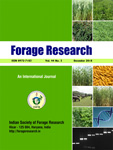RABEEN ABDUL GAFOOR*, SHARU S. R., SHALINI PILLAI P., USHA C. THOMAS, GAYATHRI G. AND PRATHEESH P. GOPINATH
College of Agriculture,
Kerala Agricultural University, Vellayani, Thiruvananthapuram-695 522 (Kerala), India *(e-mail: rabeen.gafoor6@gmail.com)
(Received: 30 May 2025; Accepted: 9 June 2025)
SUMMARY
The present investigation entitled ‘Assessment of growth and yield characteristics of fodder bajra (Pennisetum glaucum L.) varieties under varying shade levels in the Southern Laterites of Kerala (AEU 8)’ was conducted during Rabi 2023 and Summer 2024 at Instructional Farm, College of Agriculture, Vellayani, Thiruvananthapuram, Kerala, to identify suitable fodder bajra variety under open, 25 per cent and 50 per cent shade conditions. The three experiments were laid out in randomized block design with six varieties, viz., BAIF 1 (V1), TSFB 15-4 (V2), TSFB 15-8 (V3), TSFB 17-7 (V4), CO- 9 (V5) and CO-10 (V6) with four replications each. The variety V1 recorded the highest plant height, number of leaves, leaf length, leaf breadth, green fodder yield and dry fodder yield in both the seasons in all experiments. The variety V1 exhibited excellent performance under shaded conditions, yielding well and demonstrating that fodder bajra can be successfully cultivated in partially shaded environments such as coconut gardens and other shade-dominant cropping systems. Hence, BAIF 1 can be considered an optimal fodder bajra variety for both Rabi and Summer seasons, as its ability to tolerate shade makes it well-suited for inclusion in existing cropping systems, thereby contributing to the current fodder requirements.
Key words: Fodder bajra, shade levels, varieties, green fodder and dry fodder yield

